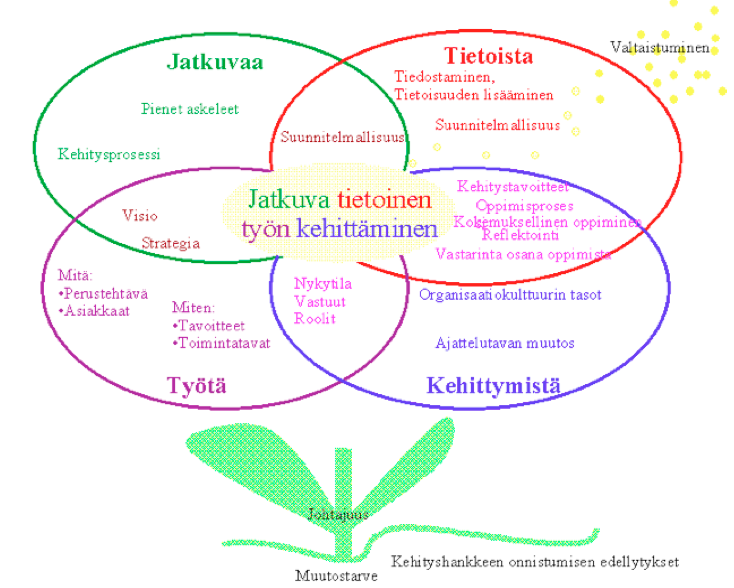Cultural Change in 1000 people Switching Platform
4.2.2010 — This report describes a large successful case of a goal oriented managed change, based on empowerment and reflection. The organizational culture and emergent nature of the change were respected by a continuously adaptive approach.

Abstract
This report describes a large successful case of a goal oriented managed change, based on empowerment and reflection. The organizational culture and emergent nature of the change were respected by a continuously adaptive approach.
A significant improvement was reported in the atmosphere and work of teams, departments and leadership teams, and from personal perspectives.
Lately retrospectives have become popular as the reflective learning practice along the Agile SW development movement. I hope this report encourages to invest in a learning culture, let it be called Kaizen, learning organization or retrospectives.
The organization in question was Switching Platforms, Nokia Networks,about 1000 people in matrix organization, developing a distributed operating system for telecom switches. The change program was initiated bottom-up and sponsored by the strong management team of the SWP.
The program continuously adapted to the real conditions and capability. It was continuing to add value from 1998 to 2002 until ended with a radical organizational change. The following was achieved:
- An adaptive organization-wide development process lasting for 4 years
- A tailored approach, fit to the organization and situation, including tools, communication material, coach pool and the structure to lead and develop the change.
- A tailored training program for change agents/coaches. It was based on experiential learning, and eventually became a leadership training.
- 11 groups of 12 participants in the basic training of 1+2+2+1 days. Value for oneself 5.6/6, value for own development project 5/6.
- 3 groups of 8 people in the advanced training program of 1+2+1+2+1 days
- 3 internal coaches of coaches consulted the managers, facilitated workshops and supported the team level local development projects
- 150 recorded local projects, covering about 75% or the organization
- Coach network with meetings, reading circle, peer consultation
- Clear change in the culture, knowledge, personal growth, change resilience
Context
The organization in question was Switching Platforms, Nokia Networks, developing a distributed operating system for telecom switches. The organization was a typical matrix with separate project organization, the line being responsible of people and the software maintenance.
From 1998 to 2000 the number of people grew from 650 to 1000. The majority of employees were men with technical education. The average age was about 33.
The rate of changes in the surrounding organization was growing all the time. Major reorganizations occurred 1/2000 and 8/2000. From 8/2000 to 2002 there was a greater turmoil in the wider organization. The investment into the change program was decreasing, but the coaches skills proved very useful in supporting the organization in adapting to the the continuous change.
Starting point and the goal
At the starting point the culture was characterized by extensive specialization and hierarchical leadership. It was natural, because the 2G standard defined the product hierarchy. Individual designers working with their own piece of code in their own room. Project managers tracked and agreed the resourcing. Elite decided what was going to be implemented. Separate testing organization was just starting to grow. Hardware development was part of the organization, but in another dimension of existence.
The management sponsored the change program to achieve:
- An organization, which is able to flexibly redirect and adapt to the changes in the environment.
- Self-organizing teams, that go to the same direction, are able to learn from their own work and thus develop continuously. Thus leading to quality and productivity.
- Empowered individuals, who experience ownership of their work, and who are willing to develop their competence and ways of working.
These goals were written around 2000, when Agile was not yet fashionable nor known to us.
Preparations 1H1998
The change program started with the planning by the external consultant and the internal owner. The sponsoring and goals were agreed with the top management team.
The next step was to find a program team. It was based on volunteering and enthusiasm about teamwork. The members represented different parts of the organization and different roles from designers to second level managers.
The task of the program team was to learn by combining the internal context knowledge with the external understanding of human behavior. The following was made:
- Current state analysis about the ways of working in the organization, by questionnaire and interviews.
- Designing an contiguous development approach, that would be credible and relevant for the teams, including questionnaire tools, training materials and workshop techniques.
- Preparing communication material, easily accepted by the culture.
- Planning the tailored training program for internal coaches.
Creating foundation 2H1998
Communication was promoted from the management. Teams at the first two organizational levels were encouraged to have a one hour presentation by an experienced coach. The presenter was carefully selected to ensure positive result. This was voluntary for the teams, still some meetings were tense. First battles with the resistance.
One department never started. In some teams you only needed to give permission to inspect and adapt, and enthusiastic work started immediately.
The first training group finished and fourth started.
The program team continued to learn about the culture and develop the approach. Experimenting and adjusting of the change program was needed, when the real work started in the organization.
Deepening 1H1999
The work started earlier continued. The basic training groups 2 to 5 finished.
The advanced training groups 1 and 2 started. With selected participants the advanced training went deeper into the group dynamics, providing more material for reflection and action learning.
Managers got interested and started to participate the training program. Management teams started to develop their work.
A research was made and get togethers were arranged for the coaches.
One second level management team did 1.5 years of serious development work with very good results.
Expanding 2H1999
The work done so far continued and started to bear fruit.
The program team was developing the approach to more specific needs, like special training group of project managers and improved toolbox for coaches.
There was special effort to cover as much of the organization as possible, with local coaches.

Gradually covering the organization. At some point the general opinion turns favorable. Some parts may never be covered voluntarily.
There was more focus to the management, but with less result. The sponsoring management team did not start reflective work themselves, and the attitude cascaded downwards. It is possible, that the approach was initially prepared and/or communicated from the developer team perspective. Or the management teams felt more insecure.
Institutionalizing 1H2000 – 8/2002
The slogan was to have work development as integral part of everyday work.
The developing of the approach was on wider basis. One advanced training group developed metrics for development.
The training program proved valuable. Even when the sponsoring of the whole change program gradually weakened, the training program was appreciated by the participants. There was a group with several of second level managers. The last training group finished in the spring 2002.
A large (300 person years) product program used coaching, and received a companywide leadership award.
The amount of reorganizations, even dramatic, was increasing. The ability of the organization to inspect and adapt was beneficial. The pool of coaches ran workshops and helped the organization to cope with changes.
Lucky consequences
When planning investment in change programs like this, often only calculable results are considered. The following consequences can be traced back to the change program now, seven years later.
- Many coaches are now capable managers
- The coach training program spawned the Constructor training program for program managers
- The skills of the coaches proved valuable and rare in later organizational hassles, especially when building after changes.
- The untraceable effects. You can imagine when reading the testimonials at the results chapter.
The key points of the approach
A unique approach was developed by combing internal research and external experience:
- To achieve the relevance and credibility for the buy-in
- To optimally use the effort and learning curve of the organization
- To combine internal context and external general knowledge
Intensive co-work of the external and internal consultant, who lead the program team, and the whole change program. The Society of Organizational learning has studied about 10 large successful cultural change programs, and every one of those had this intensive external-internal co-work.
The program team was learning, teaching and planning next actions. It is recommended to have people with diverse status and location.
The main tool to support the change was the training program for internal coaches/change agents. It was concentrating to the behavioral aspects of change. The method was based on experiential learning/action learning. It was extremely important to have a pair of internal and external coaches with equal status. Main themes were:
- Modeling the working environment
- Studying the organizational culture
- Resistance
- Role, Principal task, clarifying the assignment
- Planning the meeting structure of one’s own development project
- Team development, dependency
- Leadership, organizational theories
- Using questionnaires
- Ending
We respected the power and mechanisms of the culture, both when analyzing the organization and planning for the change program.
The key value was empowerment. The participation was encouraged but voluntary. The communication strategy was to make groups painfully aware of the current situation, and to offer support in solving it by own learning.
The change does not happen without resources. There needs to be some people to whom this is the main work. People need time for their part-time coaching work.
It is wise to collect formal metrics and statistics, to continuously negotiate with the sponsors. The flower of the key principles (Continuous Conscious Work Development detailed) that evolved during the change program, recorded by one of the advanced training groups. Please forgive the language, I will translate this when someone seriously requests:

The principles that emerged during the project.
Key learnings
Learned and proved
- The external and internal coaches’ intensive co-operation was fruitful.
- A heterogenous program team, that leads the learning was productive and challenging at times. It is the consciousness of the change program. The team gathers insight from around the organization, guard the interest of different perspectives and take a credible message back to their home organization.
- Reflection, experiential learning, inspect and adapt, whatever you call it, creates permanent learning.
- The more people invested in the change program the more learning they got themselves.
- Faith in ourselves. We learned whatever was needed, by looking from outside and reflecting ourselves.
- It is possible to empower people to take ownership.
- A lot of learning in organizational culture, change management, leadership, all applicable to own context.
- When you work at the individual, group and organizational levels, the levels support each other.
- Both And. Work with extremes, not diluted average. Both micro and macro level. Both planned and sensitive to the situation. Both down and bottom up. Both concrete details and condensed slogans.
- Never underestimate stupidity. Never underestimate the ability to learn. People always make wise choices based on their local perception.
- A tailored training program for internal coaches is effective, adaptive and economical.
- The organization is setting the speed. Pushing would waste energy and eventually slow you down.
- The friction or resistance is sometimes at sponsoring, sometimes at teams, and takes time.
Succeeded
- New kind of organizational culture, daily habits and leadership.
- The organization proved it’s change resilience in later changes, and the coaches even after the
- organization was gone.
- Increased co-operation, productivity and meaningfulness of the basic work.
- Awareness of work development at individual, group and organizational levels
- Many successful development activities.
- The change program demonstrated its message – continuously learned from experience.
- Extensive learning of the active ones.
Did not succeed
- The whole organization was not covered.
- All local projects did not succeed – more support would have helped.
- The change program was drained from good coaches, they were immediately drawn into manager positions and other demanding work. Only the top trio could invest enough time from the change program’s perspective. Two people eventually became coach of coaches.
- Sponsorship from the top management was loyal but they never started the development work at their own management team.
- Continuous reorganizations killed most of the local development projects. People got tired to start all over all the time.
- We were not able to invent how to apply long term conscious development in a short term organization.
- If we only had known about XP, Scrum, Agile, Lean… in the leadership sense we were close, but did not have anything for process and technical practices. Some XP practices were tried out when the change program was close to the end.
Results
The following testimonials describe the change. We trust that the sponsoring management did the correct judging from the profitability perspective, when they continued the project.
Everyone attending the coach training was expected to lead an own development project. About half of the started projects actually achieved something according to the corresponding coach. The managers of the teams estimated that 65% of the development projects were clearly useful (4/5) and 12% were very useful (5/5).
- Effectiveness of the work through improved and standardized practices
- Work is more meaningful
- Atmosphere and spirit, free communication, initiative, ownership and feeling of safety have improved
- Better meetings, meeting practices, clear principal task
- Sharing workload, the team contributes to the leadership, the leader is not alone
- Understanding the organization, teams responsibilities and roles, creating knowledge
- Change resilience
- Speaking up, feedback
- Activity, commitment, ownership
- Changing is frustrating, laborious and starts slowly
The training program
- The value for own professional development: Mean 5.31/6. Median 6/6, minimum 4/6.
- The value for the own local development project: Mean 5.00/6. Median 5/6. Minimum 3/6.
Coaches experienced the following:
- I have learned coaching leadership, also in my manager role
- I have widened my perspective outside my own team
- I go tools for leaders’s work, workshops, group dynamics, interaction, knowing oneself
Managers about their teams/departments
- Coaches have competence and positive contribution to my leaders work
- Ownership, initiative and productivity have improved. Teams develop their practices spontaneously.
- Better communication
Leadership teams
- Leadership has been distributed. The team takes care of the department together, delegating work and power to individual team leaders as needed.
- People take responsibility and have initiative. Less directive approach needed.
- Team members know each other better, there is more pair and small group work, which has improved the quality
- Improved time management and standardized ways of working
- Learning leadership together
Leaders’ own work
- Leaders’ workloads has reduced
- Open communication, positiveness and trust
- Change in leadership
- involve more people in preparing decisions
- people are more committed when they are heard
- discipline in working together
Contributors:
Kati Vilkki main organizer and coach, Soile Aho consultant, Ari Tikka coach, Antti Heimonen, Seppo Taanila, Aila Laisi, Lauri Närhi, Leea afHeurlin, Kirsi Lagus, Jyrki Innanen, Sami Lilja, Raija Tamminen and dozens of other activists. Please notify me when you wish to have your name here.

